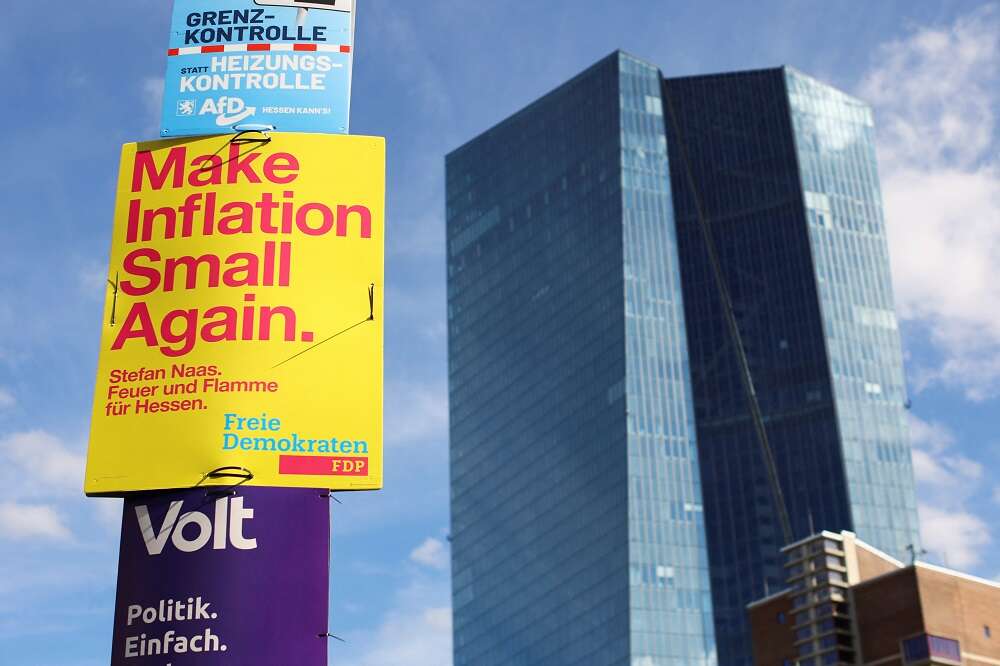
FRANKFURT (Reuters) -European Central Bank policymakers want to soon start discussing how to tackle the multi-trillion-euro pool of excess liquidity sloshing around banks, with raising reserve requirements a possible first move, six sources told Reuters.
The debate, likely to start at the ECB’s next meeting in Athens on Oct. 26 or at an autumn retreat for policymakers, marks a new phase in its fight against inflation.
The central bank for the 20 countries that use the euro has already raised interest rates 10 times to record levels but inflation remains well above its 2% target.
With rates likely on hold at least until December, policymakers are now starting to shift their focus to the cash that they injected into the banking system over a decade of bond purchases.
This stash of money dulls the impact of their rate hikes by reducing competition for deposits and results in hefty interest payments — and ensuing losses — by some central banks.
Discussions on how to reduce excess liquidity will focus on three areas, the sources said: the amount of reserves banks must keep at the ECB, the unwinding of its bond-buying programmes and a new framework for steering short-term interest rates.
An ECB spokesperson declined to comment for this story.
RAISING RESERVE REQUIREMENT
Several policymakers are in favour of raising the amount of reserves that banks must park at the central bank – on which they do not earn interest – from 1% of customer deposits to a figure that could be closer to 3% or 4%, the sources said.
The sources said this would have the dual benefit of mopping up cash from the banking system and reducing how much the ECB and the euro zone’s 20 national central banks pay out in interest on deposits, which has led to large losses for some.
They thought this could be an easier step for the ECB to take, because policymakers had already discussed it at July’s meeting and because mandatory reserves are currently puny at 165 billion euros ($176.02 billion) compared to excess liquidity of 3.7 trillion euros.
However, one source said some policymakers wanted to bundle a decision on reserves with those on the ECB’s asset purchase schemes and interest-rate framework, which could be a much slower process.
The debate about shrinking the 4.8 trillion euro pile of debt hoovered up under different schemes by the ECB since 2015, mostly to avert the risk of deflation, was seen by the sources as more difficult.
Most saw scope for phasing out the ECB’s Pandemic Emergency Purchase Programme (PEPP) by not replacing maturing bonds, but all were nervous about upsetting financial markets, particularly investors in Italy’s government bonds.
ECB President Christine Lagarde said last week that policymakers had not discussed the bond-buying schemes at their latest policy meeting. She described the PEPP as the ECB’s “first line of defence” to preserve policy transmission – central bank jargon for bond market stability in the most indebted countries.
Slovenian central bank governor Bostjan Vasle recently backed selling bonds bought under the ECB’s older Asset Purchase Programme, which is less flexible than the PEPP. But one of the sources pointed out that this would result in even bigger losses for the ECB as those bonds were mostly bought at higher prices.
The sources said that delicate balance meant a decision on the bond-buying schemes might not come this year, and that any change was very unlikely to take effect until early 2024 or even later in the spring.
Slovakian governor Peter Kazimir said on Monday he would wait another six months before making a decision on PEPP.
Finally the sources said they had not even really started debating the policy framework – whether the ECB wants to continue setting a floor for the interbank rate or go back to a corridor-system in which it provides a lower and upper limit.
The former requires the ECB to keep more excess liquidity in the banking system, although none of the sources would venture a guess about how much, saying it depended on the exact design.
The sources expected this debate to spill over into 2024 and saw no need to rush it as the amount of excess reserves sitting at banks meant the ECB was effectively stuck with a floor system for years to come.
A study presented at the ECB’s summer symposium in Sintra showed that now monetary stimulus is no longer needed, the ECB could shrink bank liquidity to between 521 billion euros and 1.4 trillion euros while still meeting banks’ need for reserves.
($1 = 0.9374 euros)
(Editing by Catherine Evans)


